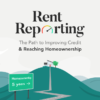Let’s pretend you’re standing on the edge of a cliff and you have to jump over a huge ravine to land safely on the other side. As you look at your options, it seems impossible and you can’t imagine making it. Then, out of nowhere, someone points to a bridge just a few yards down from where you stand, and it seems like all your problems are solved!
This is what it can feel like to first-time homebuyers when they hear about “rent-to-own”. Instead of that big jump from renter to owner, there’s a bridge that connects the two. But before you get too excited, let’s take a look at what you are getting into when you consider a rent-to-own deal.
How rent-to-own works

A homeowner plans to sell their house but instead of a traditional sale (where it’s placed on the market and makes one transition from them to the new owner at closing), they start with a tenant. Let’s say that tenant is you – a renter who wants to become a homeowner but may not yet have the necessary down payment or credit history to qualify for a mortgage.
The lease option
You sign an agreement to rent the property but along with traditional lease terms, you pay an upfront amount, called a lease option. A lease option is essentially a security deposit that gives you the option to buy the house at the end of your term. Instead of the traditional 12-month lease, this lease is usually 2-3 years. Expect to pay at least 2-3% of the purchase price for this option – and up to 7.5% in some cases. If the average is 3.5%, this means you’ll need $7,000 to get into the lease-to-own option instead of a normal security deposit that may be equal to half, or one month’s rent.
Inflated monthly rent
On top of those fees, you’ll likely be paying an inflated monthly rent amount. The reason being is that in addition to the lease option fee, you’re paying extra money every month that will act as a part of your down payment down the road. For example, if a comparable home in your area is renting for $1,500, you may expect to pay $1,750. The extra $250 is being held by the homeowner in escrow and will amount to $9,000 ($250 a month x 12 months x 3 years) towards the purchase if you decide to buy the house that is.
It’s usually too good to be true
When you hear rent-to-own described as a lease-to-own mortgage, it sounds too good to be true. That’s because most often, it is. The rent-to-own pros and cons seem to fall heavily on the cons when you start to add up rent-to-own interest rates and fees. It doesn’t take long to realize that your dream of homeownership can turn into a nightmare with rent-to-own. So, let’s take a look at the pros and cons of rent-to-own, starting with the cons (because not surprisingly, the pro list is pretty short)!
Disadvantages of rent-to-own
Not only are you faced with high upfront costs and inflated payments, if anything changes and you don’t buy the house, you lose that money. If you took the same money we talked about earlier ($7,000 for the lease option and the $9,000 in extra payments) you’d have $16,000 at the end of an equivalent 3-year period – that’s money that could go towards a down payment. If the first house you tried to buy fell through in a traditional home buying process, no problem, you could take your money and move on to house #2. The same doesn’t apply with rent-to-own and if you choose for any reason (even a good one, like you found out the house is a dump!) not to buy the house, you forfeit that $16,000 you’ve invested!
Limited options
Buying your first home can be stressful at times – between finding your dream home to getting approved and dealing with inspections and appraisals. Before you even start, you have hundreds of homes to choose from – and many ways to protect you once you have a contract. The same can’t be said with rent-to-own homes. You immediately eliminate most homes because they’ll be sold the traditional way, and you lose almost all protection when it comes time to close.
Basically, you’re stuck
Think of rent-to-own kind of like being forced to propose after one date. It doesn’t matter if you find out later your soon to be spouse is a little crazy, you committed before having all the information. And believe it or not, calling off an engagement is probably a lot easier to do than getting out of a rent-to-own commitment. You’ll lose your investment and be homeless if you don’t complete the purchase. On the upside, you won’t have any furious in-laws knocking your door down.
Rent-to-own scams

The worst con of all is potentially becoming the victim of a rent-to-own scam. Because an upfront commitment is required, rent-to-own home scams have become prevalent, preying on individuals who hope the option will be their bridge to home ownership.
Let’s take a look at how to spot a rent-to-own scam, just in case you plan to consider this option on your path to home ownership.
Poor home condition
One easy way to fall victim to a rent-to-own scam is to avoid getting a home inspection done, BEFORE signing any paperwork. It may seem like a real pain to take the extra step of requiring an independent property inspection, especially if you have to pay for it in addition to all the other upfront costs. And that’s one of the reasons this scam works so well. Once you’ve signed the paperwork, you’re locked into buying the house (or walking away and losing all the money you’ve paid in), whether or not the seller disclosed all the lingering repairs that are long overdue.
Additionally, don’t assume it’s ok if the seller DOES disclose issues to you because, in many rent-to-own scenarios, the cost of repairs can fall to the tenant. Even if the seller promises to pay for the repairs, “as soon as the agreement is signed”, never sign the lease if it’s not explicitly agreed to in writing because their promise isn’t worth much if it doesn’t match up to the agreement you signed. This is a common way scammers offload a property with major issues and one trick you want to avoid.
Looming foreclosure
One problem that’s hard to spot is the financial security of the landlord. Let’s say they haven’t paid their mortgage for six months and their integrity leaves something to be desired. If they really wanted to sew some bad karma for themselves, they could list their home as a rent-to-own and collect that large deposit from the new tenant, knowing full well it’s just a matter of months before a foreclosure occurs. What rights would you have as a tenant? Not much because if you’re in the 2-3 year agreement period where you’re just a renter, your rights as an owner don’t exist. Whether or not you’ve been making payments that SHOULD have been going to the mortgage, if a scammer decided to take the money and run, your only option is to start looking for a new place to live.
The “seller” isn’t exactly the owner
It’s sad that this scenario even exists, but we promised to give you all the warnings so here’s how it works. Let’s say someone canvases certain areas looking for homes that are vacant or maybe even for sale. They take some pictures and post a “rent-to-own” listing online, offering a great deal on a beautiful home. You meet them one Saturday afternoon and they tell you how they grew up in this family home, playing soccer in the backyard and chasing their brother around the kitchen while their mom made Sunday dinners. You get sucked into the stories they tell and can’t believe this home will be yours in a few short years. The main problem? The person you’re bonding with has broken into the home and has absolutely no rights to the property. The minute you pay the large deposit, they’ll disappear and when the real owners come back you’ll be accused of squatting and once again, need to start looking for a new place to live.
As unbelievable as these stories are, they happen every day and rent-to-own options are an easy way to fall victim to a scammer. By now you may be asking yourself, what are the pros? So, as promised, here are some reasons you may still be considering a rent-to-own home.
You might be able to get into a home faster
This is the one pro that may be enough for you to try a rent-to-own option, but we would recommend proceeding with caution. Alternatively, if you really can’t get into a mortgage, take the time to fix what is wrong. A lot can change in a year so consider a traditional rental and focus on improving your credit, building up a down payment and finding ways to go the traditional route. Remember, even with a rent-to-own, you may be getting into a home faster, but you’ll be paying more and facing more risk. Save that money instead and ensure it stays safe, no matter what home you choose to buy.
Proceed with caution
If you do decide to proceed with a rent-to-own, check – every – detail. Learn about the fees – those that you’ll pay up front for the option to buy, and the monthly portion of your rent that will be set aside in escrow. Pay attention to the fees and responsibilities associated with house maintenance and major repairs and definitely spring for an inspection before signing any paperwork. Have a lawyer or advisor review your agreement, looking for simple clauses the seller may try to use as a “gotcha”. One example of this is missing a payment or even being late on your monthly rent. In a normal rental, you may pay a late fee but with a rent-to-own, it could dissolve your entire agreement. If you break a term in the agreement, even as simple as being a few days behind, you will typically forfeit everything you’ve paid up to that point, as well as your option to buy.
Focus on saving for a real home
Here at Digs, we have a pretty strong opinion about rent-to-own options and just in case you missed it, we recommend avoiding them at all costs.
Instead, we focus on taking the quickest path to becoming a homeowner, while minimizing unnecessary risks. We offer savings education and a plan to help you save the necessary down-payment amounts faster than you think. Plus, we know all the best options for first-time home-buyers, including what programs, grants and loans are available. We believe in using what works for you, but we can’t recommend rent-to-own just because it sounds good in theory. Instead, stick around to learn what works, how to protect the money you save, and how to close on your first house before you know it!







